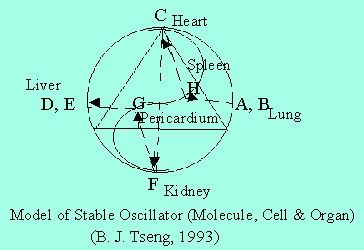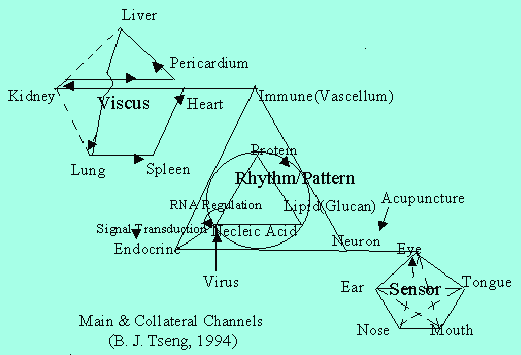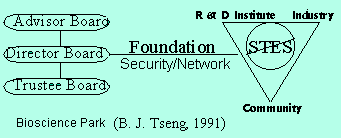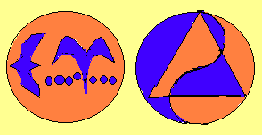STRUCTURITY: PAN-EVOLUTION THEORY - THE PRINCIPLES AND APPLICATIONS
Bangzhe J.Zeng
Contents:
Preface: The Positive and Synthetic Thoughts of Organisms
PART I.STRUCTURITY: PAN-EVOLUTIONAL COSMOS
Eternal Cosmos and Changing of Systems
1. Ontology of Systems Structure
1.1 Substance Entity Structure: Entity, Develop, Exist Axioms; Pan-stability, Pan-interacting,
Pan-structure Pricinples;
1.2 Mendal Symbol Structure: Pan-relation, Pan-organism, Pan-inertia Pricinples;
1.3. Concepts, Principles of Structurity: Structure Tolerance, Adaptation, Fluctuation,
Interweave, Transform Theorems
2. Creatism of Construct Mutation
2.1 Interaction and Structure Stratificate:
Solitary Stratum "+","-"Transfer Make Interaction Match Structure Stratum;
2.2 Mutation, Transmit of Interaction:
Same Stratum Systems Interacting Transfer to Other Stratum, Systems Interacting in These Ways: Open,
Close, Cycle;
2.3 Structure Stability Pattern:
Diamond, Snow & C60Structure
stability Based on Tetrahedron Structure
(Four Color), C1/4+2C2/4+C3/4, C1/4+6(C2/4+C3/4).
 3. Simi-Structure Hologram Organism
3.1 Development of Systems: Object, Motion, Change System Structure, Fuction, Developing,
Intergate. Self-construct Body Develop from Subsystem to Suprasystem Structure Transference:
No-growth Inner Contracting Make Solidity, Fluid Alternation Sphere Structure; Growth Assimilate
Make Fractal Structure
3.2 Hologram of Structure: Developing Model, Cosmos and Brain is Time, Space Fractal Structure.
Any Object is Simi-structure from Subsystem to the Suprasystem;
3.3 Structure Logic: Syntax Maded of Vi.t., Aj.v, Nc.u, P(C), Cosmos-Substance, Life, Mentality, Culture-Science,
Arts, Religion, Structurity Laws: Integration ("O"), Adaptation("S"), Construction("V").
3.4. Unification and Creation
S+I=Constant, Eternal Interation, Asymmetry Stable and Mutation Split, Changable Creatism of Cosmos.
3. Simi-Structure Hologram Organism
3.1 Development of Systems: Object, Motion, Change System Structure, Fuction, Developing,
Intergate. Self-construct Body Develop from Subsystem to Suprasystem Structure Transference:
No-growth Inner Contracting Make Solidity, Fluid Alternation Sphere Structure; Growth Assimilate
Make Fractal Structure
3.2 Hologram of Structure: Developing Model, Cosmos and Brain is Time, Space Fractal Structure.
Any Object is Simi-structure from Subsystem to the Suprasystem;
3.3 Structure Logic: Syntax Maded of Vi.t., Aj.v, Nc.u, P(C), Cosmos-Substance, Life, Mentality, Culture-Science,
Arts, Religion, Structurity Laws: Integration ("O"), Adaptation("S"), Construction("V").
3.4. Unification and Creation
S+I=Constant, Eternal Interation, Asymmetry Stable and Mutation Split, Changable Creatism of Cosmos.
PART II. LIFE SYSTEMS: Pattern (System) Genetics
Biosystem is the morphogenesis system of structure complement each other and structification, functional couple and interflow bounds
growth, cordinative transformation and holographic symmetry. Genetics be explored the relation of
phenotype with genotype (Mendelian Genetics);
regulation of gene expression (Molecular Genetics); and the structural evolution of genomes,
unified theory of heredity, development and evolution (Structural/System Genetics).
1. The Logic of Organisms Structure
1.1. The Origin of Life System: Cell Origin and Regulation of Cell Metabolism, Ai+A0->Aj+A(i+1), Aj->A0.
Proteins groups and molecules interaction of essential biochemical system in original cell, adapted in cell species,
and induced in tissue cells. The metabolism systems of organelles, Intra membrane apparatus,
movetive skeleton, intracell and intercells signals.
1.2. Structure of Holographic Reenact:
The logic of self-renew, self-duplicated, self-regulated, self-adaptated information control
system, C0->Ci+Cj->C(i+1)+C0.
1.3. Organization of Genome
Genetic and Physical Gene Mapping: Genomic and cDNA maps, compare the genes organization
in genome with the expression pattern of proteins.
2. Program Expression of Genes
Morphogenesis and Adaptative Development:
2.1. Regulation of Gene Expression and Protein Degradation: The regulate and structural elements in gene for
specific expression and function of proteins; Gene transcription, mRNA localisation; Proteins translation,
fold, targeting and degradation; The assemble and degradation of cell compartments;
2.2. Cell Mitotic, Differentiation and Prolification, apoptosis. Signal molecules
interacelluar asymmetry, duplication of cell genome and tissue specificial expression of
genes by genomic program, Specific induce expression and differentiation in vitro; 2.3.
Oscillation and Patterning: The tissue cells be constructed in coherent body: Cell cycle
and fate be controled by secretory (neurohumoral) rhythms of signals.
The regulatory pattern of neuron, immune and endocrine, circulatory cells developed from
ectoderm, endoderm and mesoderm of embryo. The notochord of head and trunk inductors,
double gradient signal regulation, coordanative movement of embryo cells groups.
2.4. Pharmacognacy, Psychosomatic Medicine: The stimualation pattern of experience
strengthen specfic connections among neurons, specific protein biosysthesis.
 3. Cellular Mutation and Evolution of Organisms:
Self-Organization Co-evulotion: The natural and artificial evolution (amplification,
rearrangment and transposon) of genes in genome.
3.1. Replication and Homologous Recombination: Genetic crossover, genes rearrangment
in duplication, mutation and repair of DNA; 3.2. The
Mobile Elements of Gene: Virus, cancer genes transposon causes cells
mutation of genes in genome, Gene target and homologous recombination;
3.3. Multify Stratum Construction in Genome: Intereacting among genes in host and the
genetic coadaptation, Genes group, genes family and genes chain in the multify
stratum construction of genome from prokaryocyte, eukaryocyte to multicells organism.
3.4. Laws of Genetic Structurity
Systems (Pattern) Genetics: the genetics and bio-logic of the
molecular, cellular and organisim patterning; the structure (organization), function (
development, specific expression) and mutantion (evolution, self-organization) of genomes.
1.) Structure Integration: Cordinative organization of genes in genome, the independent
phenotype is controlled by genes group (multigenes); 2.) Function Adaptation: Duplication (amplify)
of cell genome, tissue-specific expression of genes, the expression of genes chain depends on
the self-adaptation in signals field of the cell microenvironment; 3.) Construct
Stratification: Recombination, multiple stratum structure of genome, the mutation in genes
family of gene transpose, recombination and amplification.
3. Cellular Mutation and Evolution of Organisms:
Self-Organization Co-evulotion: The natural and artificial evolution (amplification,
rearrangment and transposon) of genes in genome.
3.1. Replication and Homologous Recombination: Genetic crossover, genes rearrangment
in duplication, mutation and repair of DNA; 3.2. The
Mobile Elements of Gene: Virus, cancer genes transposon causes cells
mutation of genes in genome, Gene target and homologous recombination;
3.3. Multify Stratum Construction in Genome: Intereacting among genes in host and the
genetic coadaptation, Genes group, genes family and genes chain in the multify
stratum construction of genome from prokaryocyte, eukaryocyte to multicells organism.
3.4. Laws of Genetic Structurity
Systems (Pattern) Genetics: the genetics and bio-logic of the
molecular, cellular and organisim patterning; the structure (organization), function (
development, specific expression) and mutantion (evolution, self-organization) of genomes.
1.) Structure Integration: Cordinative organization of genes in genome, the independent
phenotype is controlled by genes group (multigenes); 2.) Function Adaptation: Duplication (amplify)
of cell genome, tissue-specific expression of genes, the expression of genes chain depends on
the self-adaptation in signals field of the cell microenvironment; 3.) Construct
Stratification: Recombination, multiple stratum structure of genome, the mutation in genes
family of gene transpose, recombination and amplification.
PART III. GLOBALIZATION OF HUMAN CULTURE
1. Brain Transform System:
1.1 Artificial Society: Bi+B0->Bj, Bj+B0->Bi+1.
1.2 Regulation of Culture Structure: Economic Development, Bio-logic Society.
 2. Artificial Evolution of Biosystems:
Biosystems Analytics, Informatics, Transgenics, Bionics, Genomics and Bioethnics.
Bioengineering inludes the bionics of biosystem, transgenic organisms and ecological engineering.
2.1 Transgenic Organisms
From Genomic DNA & cDNA library, gene mapping, isolation & cloning to gene expression,
transgenesis. 1.) Transgenic system includes gene synthesis, sequence and plasmid &
virus vectors construction, transformation with Bacteria, recepte cell and tissue culture,
gene transfection (sperm cell, microinject, gene gun, virus transfer and ES cell, transposor intergrate methods),
cell fuse & nuclei, embryo transfer, specific induce expression & selection screen. 2.) The
Applications of Transgensis: to change genome by insert into or knock out be used for manufact
products (bioreactor, organs transplantation), genetic improvement (organism breeding, gene therapy)
and research methods (disease models, gene regulation).
2.2 Bionic Engineering
1.) Biomolecular Computation: Artificial life, genetic logic of self-organization.
2.) Biochips: Bionic machines, intelligence robot.
3. Culture Evolution and Human in Future
The Time of Biosystem Science and Engineering.
3.1 Evolution of Culture
3.2 Artificial Biosystems
Future world of human will be cultural evulotion system of machine and organism integrated.
The R & D of artificial organism, intelligence robot are the high technology of human economics
and industrials.
Forward: Classified Knowlege Systems of Human
Figures:
Molecular Cell, Organ Morphogenesis.
Signals in Genes Program Expression.
Appendix:
1. Brief History of Genetic Science and Technology
2. Lists of Biotechnology, Bioinformatics Companies
2. Artificial Evolution of Biosystems:
Biosystems Analytics, Informatics, Transgenics, Bionics, Genomics and Bioethnics.
Bioengineering inludes the bionics of biosystem, transgenic organisms and ecological engineering.
2.1 Transgenic Organisms
From Genomic DNA & cDNA library, gene mapping, isolation & cloning to gene expression,
transgenesis. 1.) Transgenic system includes gene synthesis, sequence and plasmid &
virus vectors construction, transformation with Bacteria, recepte cell and tissue culture,
gene transfection (sperm cell, microinject, gene gun, virus transfer and ES cell, transposor intergrate methods),
cell fuse & nuclei, embryo transfer, specific induce expression & selection screen. 2.) The
Applications of Transgensis: to change genome by insert into or knock out be used for manufact
products (bioreactor, organs transplantation), genetic improvement (organism breeding, gene therapy)
and research methods (disease models, gene regulation).
2.2 Bionic Engineering
1.) Biomolecular Computation: Artificial life, genetic logic of self-organization.
2.) Biochips: Bionic machines, intelligence robot.
3. Culture Evolution and Human in Future
The Time of Biosystem Science and Engineering.
3.1 Evolution of Culture
3.2 Artificial Biosystems
Future world of human will be cultural evulotion system of machine and organism integrated.
The R & D of artificial organism, intelligence robot are the high technology of human economics
and industrials.
Forward: Classified Knowlege Systems of Human
Figures:
Molecular Cell, Organ Morphogenesis.
Signals in Genes Program Expression.
Appendix:
1. Brief History of Genetic Science and Technology
2. Lists of Biotechnology, Bioinformatics Companies
REFERENCES:
1. A. N. Whitehead, E. Russell, Abridged as Principia Mathematica to 56, Cambridge University Press, 1962.
2. Albert Einstein, Leopold Infeld, The evolution of physics; the growth of ideas from early concepts to relativity
and quanta, Published by Simon and Schuster, New York, 1961.
3. B.B. Mandelbort, The fractal of geometry of nature, Freeman, 1977.
4. B.J. Zeng(Tseng), The structure of science and the future of China, Nature Information (Chinese), Vol.5, Oct. 1991.
5. B.J. Zeng, On the holographic model of human body, 1st National Conference of Comparative Studies Traditional Chinese Medicine and West Medicine, Medicine and Philosophy, Guangzhou, April 1992.
6. B.J. Zeng, Structurity: the Pan-evolution Theory, International Congress on Philosophy and Logic of Sciences, Wuhan, Oct. 1993.
7. B.J. Zeng, The rhythm stability of mammalian development, The Conference of Chinese Developmental Biologists, Beijing, Oct. 1994.
8. B.J. Zeng, Transgenic avian used as OVIDUCT BIOREACTOR, International Symposium and Exhibition on Pharmacy and Biotechnology, Shanghai, July, 1995.
9. B.J. Zeng, Self-organization and special expression of genes (Structure/System Genetics), Communication on Transgenic Animals (China, CAS), vol.3, No.6-8, 1996.
10. B.J. Zeng, The fundamentals and applications of transgenic animals, Biotechnology Bulletin (China, CAAS), Vol.3, 1997.
11. Changlin Liu, Philosophy of neijing and methodology of Chinese medicine, Science & Technology Press (China), 1982.
12. D.W. Thompson, On growth and form, Cambridge University press, 1961.
13. Konrad Z. Lorenz, King Solomon's ring : new light on animal's ways, published by New American Library, N. Y., 1991.
14. Ludger Rensing, Oscillations and morphogenesis, Marcel Dekker, Inc.,1993.
15. Ludwig von Bertalanffy, General system theory : foundations, development, applications, Published by Harmondsworth, Penguin, 1973.
16. Martin Kenney, Biotechnology: university-industry complex, Yale University Press, 1986.
17. Monod Jacques, Chance and necessity; anessay on the natural philosophy of modern biology, Translated fromn the
Frence by Austryn Wainhouse, New York, Vintage Books 1972.
18. Nicolis, G. and
Prigogine, I., Exploring complexity : an introduction, W.H. Freeman, New York, 1989.
19. Peter A. Lawren, The making of fly: The genetics of patternal design, Blackwell scientific publications, 1992.
20. Schroinger, Erwin, What is life? The physical aspect of the living cell & mind and matter,
Cambridge University Press., 1967.
21. R.W.Sperry, Proc.Natl.Acad.Sci.U.S.A. 50,703(1963); R.W.Hunt & W.M.Cowan, in Brain, Circuits and Functions of Mind, C.B.Trevarthen, Ed. Cambridge Univ.Press, Cambridge, 1990, pp.19-74.
22. Weyl, Hermann, Symmetry, Princeton, Princeton University Press, 1952.
(All rights reserved SysBioEng, please cite as:
Bangzhe J. Zeng (BenJoe Tseng), Structurity - Panevolution Theory (Biosystem Medicine - Psychosomatics Thesis, 1986-1993), print in Changsha May 1994,
online by Structurity Bulletin 1999.
-(Chinese Version)-







